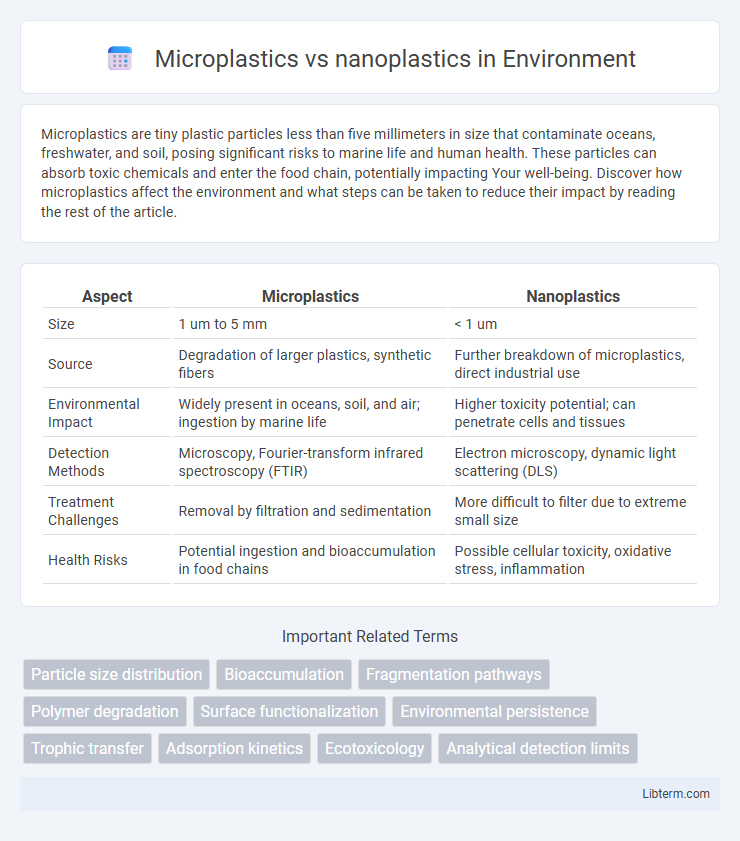Microplastics are tiny plastic particles less than five millimeters in size that contaminate oceans, freshwater, and soil, posing significant risks to marine life and human health. These particles can absorb toxic chemicals and enter the food chain, potentially impacting Your well-being. Discover how microplastics affect the environment and what steps can be taken to reduce their impact by reading the rest of the article.
Table of Comparison
| Aspect | Microplastics | Nanoplastics |
|---|---|---|
| Size | 1 um to 5 mm | < 1 um |
| Source | Degradation of larger plastics, synthetic fibers | Further breakdown of microplastics, direct industrial use |
| Environmental Impact | Widely present in oceans, soil, and air; ingestion by marine life | Higher toxicity potential; can penetrate cells and tissues |
| Detection Methods | Microscopy, Fourier-transform infrared spectroscopy (FTIR) | Electron microscopy, dynamic light scattering (DLS) |
| Treatment Challenges | Removal by filtration and sedimentation | More difficult to filter due to extreme small size |
| Health Risks | Potential ingestion and bioaccumulation in food chains | Possible cellular toxicity, oxidative stress, inflammation |
Introduction to Microplastics and Nanoplastics
Microplastics are plastic particles smaller than 5 millimeters, originating from the breakdown of larger plastic debris or manufactured intentionally for products like exfoliants. Nanoplastics measure less than 100 nanometers and arise from further fragmentation of microplastics, posing greater ecological and health risks due to their ability to penetrate biological membranes. Understanding the differentiation between microplastics and nanoplastics is crucial for assessing their distribution, environmental impact, and toxicity in marine and terrestrial ecosystems.
Defining Microplastics: Size, Sources, and Characteristics
Microplastics are plastic particles smaller than 5 millimeters, originating primarily from the breakdown of larger plastic debris and microbeads in personal care products. These particles possess diverse shapes and compositions, including fragments, fibers, and pellets, which influence their environmental persistence and interaction with marine organisms. Predominantly sourced from synthetic textiles, packaging materials, and tire wear, microplastics pose significant challenges to aquatic ecosystems due to their widespread distribution and potential for bioaccumulation.
What Are Nanoplastics? Distinctions and Properties
Nanoplastics are plastic particles smaller than 100 nanometers, significantly smaller than microplastics, which range from 100 nanometers to 5 millimeters. These particles exhibit distinct physicochemical properties, including higher surface area-to-volume ratios and increased reactivity, leading to greater potential for environmental toxicity and bioaccumulation. Their tiny size allows them to penetrate biological membranes, posing unique risks to aquatic life and human health compared to larger microplastic fragments.
Sources and Pathways into the Environment
Microplastics primarily originate from the fragmentation of larger plastic debris, synthetic textile fibers, and microbeads in personal care products, while nanoplastics often result from the degradation of microplastics and industrial processes involving nanoscale plastics. Both microplastics and nanoplastics enter the environment through wastewater discharge, runoff from landfills and urban areas, and atmospheric deposition. These particles persist in aquatic and terrestrial ecosystems, posing challenges due to their widespread dispersion and potential uptake by organisms across food webs.
Environmental Persistence and Distribution
Microplastics, defined as plastic particles smaller than 5 millimeters, exhibit significant environmental persistence due to their resistance to degradation, accumulating in oceans, soils, and freshwater systems worldwide. Nanoplastics, measuring less than 100 nanometers, penetrate deeper into ecosystems, dispersing more widely due to their small size and increased surface area, which enhances their interaction with pollutants and biota. Both forms contribute to long-term contamination, with nanoplastics posing greater risks because of their enhanced mobility and potential to cross biological membranes.
Health Impacts: Human and Wildlife Exposure
Microplastics, typically ranging from 1 micrometer to 5 millimeters, and nanoplastics, smaller than 1 micrometer, pose significant health risks due to their ability to penetrate biological barriers and accumulate in organs. Human exposure occurs through ingestion, inhalation, and dermal contact, potentially leading to inflammation, oxidative stress, and disruption of endocrine functions. Wildlife faces similar threats, with microplastics and nanoplastics causing physical blockages, toxic chemical release, and altered reproductive and developmental processes across aquatic and terrestrial species.
Detection and Analysis Methods
Detection and analysis methods for microplastics and nanoplastics rely on advanced spectroscopic and microscopic techniques, such as Fourier-transform infrared spectroscopy (FTIR) and Raman spectroscopy, which enable precise identification of polymer types at micro and nano scales. Electron microscopy provides detailed imaging of nanoplastics' morphology, while techniques like pyrolysis-gas chromatography-mass spectrometry (Py-GC-MS) facilitate chemical characterization of complex plastic mixtures. Emerging approaches, including thermal extraction desorption gas chromatography mass spectrometry (TED-GC-MS) and hyperspectral imaging, enhance sensitivity and spatial resolution for assessing environmental plastic contamination.
Regulations and Global Policies
Microplastics and nanoplastics are increasingly targeted by global environmental regulations due to their pervasive presence and harmful impact on ecosystems and human health. Key policies, such as the European Union's Plastic Strategy and the United Nations Environment Programme (UNEP) resolutions, emphasize reducing plastic pollution by enforcing restrictions on microbeads, promoting sustainable plastic production, and funding research into nanoplastic toxicity. Effective regulation demands international cooperation and standardized monitoring methods to ensure comprehensive management of microplastic and nanoplastic pollution in marine and terrestrial environments.
Emerging Solutions and Innovations
Emerging solutions for microplastics and nanoplastics emphasize advanced filtration technologies such as membrane bioreactors and nano-filtration systems to enhance removal efficiency from wastewater. Innovations include biodegradable polymers and enzyme-based degradation methods that target plastic breakdown at the molecular level, reducing environmental persistence. Cutting-edge sensor technologies enable real-time monitoring of micro- and nanoplastic concentrations in aquatic ecosystems, facilitating timely intervention and pollution control.
Future Directions in Research and Mitigation
Future research on microplastics and nanoplastics emphasizes advanced detection techniques to accurately quantify their presence in diverse ecosystems. Developing biodegradable alternatives and innovative filtration technologies aims to mitigate plastic pollution at its source. Interdisciplinary studies integrating toxicology and environmental science are crucial for understanding long-term biological impacts and informing global policy frameworks.
Microplastics Infographic

 libterm.com
libterm.com